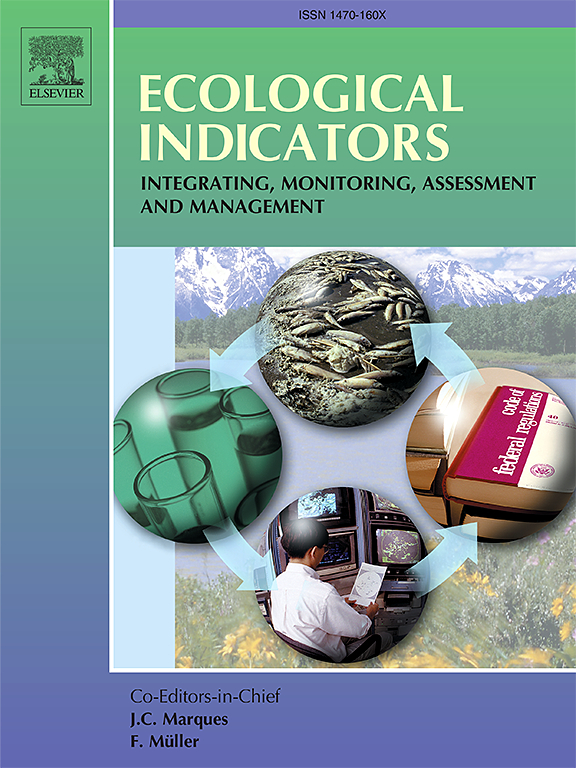Coexistence in long-term managed lakes: Limited evidence of negative impacts of invasive macrophytes on fish communities
IF 7
2区 环境科学与生态学
Q1 ENVIRONMENTAL SCIENCES
引用次数: 0
Abstract
Invasive macrophytes are widespread and can disrupt freshwater ecosystems if not properly managed. Their impact on fish is a topic of ongoing discussion, with studies reporting contrasting results. Utilizing datasets spanning 17 years of monitoring across 34 lakes in Florida, we examined the effects of the primary non-native invaders water hyacinth (Eichhornia crassipes (Mart.) Solms), hydrilla ((Hydrilla verticillata L. f.) Royle), and water lettuce (Pistia stratiotes L.), plus the entire non-native macrophyte assemblage and abiotic variables on fish species richness, Shannon diversity, abundance, length, and biomass. Together, these indicators help assess and manage the impact of invasive species and environmental changes on freshwater ecosystems. Our study was conducted at both habitat and lake scales to ensure a more thorough understanding of potential impacts. We found evidence of a marginally positive influence of hydrilla on fish species richness and abundance, a positive influence of water lettuce on Shannon diversity, and a positive effect of water hyacinth on fish length, all at the habitat scale. Notably, these effects were largely analogous to those of native macrophytes. Water temperature of about 26 °C and dissolved oxygen levels between 5 and 10 mg/L appeared to be optimal for fish. Lakes located in northwest Florida exhibited higher fish diversity and abundance. The integrated use of ecological indicators reveals that long-term management of lakes might limit populations of non-native macrophytes, thereby reducing the adverse effects of invaders on fish communities and facilitating their coexistence. This study highlights the importance of management strategies and long-term monitoring in minimizing the impacts of invasive plants on freshwater ecosystems.
长期管理湖泊的共存:入侵大型植物对鱼类群落负面影响的有限证据
入侵的大型植物分布广泛,如果管理不当,可能会破坏淡水生态系统。它们对鱼类的影响是一个持续讨论的话题,研究报告了截然相反的结果。利用对佛罗里达州34个湖泊长达17年的监测数据集,我们研究了主要的非本地入侵者水葫芦(Eichhornia crassipes)的影响。水螅(hydrilla verticillata L. f.)和水莴苣(Pistia stratiotes L.),以及整个非本地大型植物组合和鱼类物种丰富度、Shannon多样性、丰度、长度和生物量的非生物变量。这些指标共同有助于评估和管理入侵物种和环境变化对淡水生态系统的影响。我们的研究是在栖息地和湖泊的尺度上进行的,以确保更彻底地了解潜在的影响。在生境尺度上,水螅对鱼类物种丰富度和丰度有微正向影响,水莴苣对Shannon多样性有正向影响,水葫芦对鱼类长度有正向影响。值得注意的是,这些作用在很大程度上类似于本地大型植物。水温约为26°C,溶解氧含量在5至10毫克/升之间似乎是鱼类的最佳选择。位于佛罗里达州西北部的湖泊表现出较高的鱼类多样性和丰度。生态指标的综合利用表明,湖泊的长期管理可以限制外来大型植物的数量,从而减少外来植物对鱼类群落的不利影响,促进它们的共存。本研究强调了管理策略和长期监测对于减少入侵植物对淡水生态系统的影响的重要性。
本文章由计算机程序翻译,如有差异,请以英文原文为准。
求助全文
约1分钟内获得全文
求助全文
来源期刊

Ecological Indicators
环境科学-环境科学
CiteScore
11.80
自引率
8.70%
发文量
1163
审稿时长
78 days
期刊介绍:
The ultimate aim of Ecological Indicators is to integrate the monitoring and assessment of ecological and environmental indicators with management practices. The journal provides a forum for the discussion of the applied scientific development and review of traditional indicator approaches as well as for theoretical, modelling and quantitative applications such as index development. Research into the following areas will be published.
• All aspects of ecological and environmental indicators and indices.
• New indicators, and new approaches and methods for indicator development, testing and use.
• Development and modelling of indices, e.g. application of indicator suites across multiple scales and resources.
• Analysis and research of resource, system- and scale-specific indicators.
• Methods for integration of social and other valuation metrics for the production of scientifically rigorous and politically-relevant assessments using indicator-based monitoring and assessment programs.
• How research indicators can be transformed into direct application for management purposes.
• Broader assessment objectives and methods, e.g. biodiversity, biological integrity, and sustainability, through the use of indicators.
• Resource-specific indicators such as landscape, agroecosystems, forests, wetlands, etc.
 求助内容:
求助内容: 应助结果提醒方式:
应助结果提醒方式:


